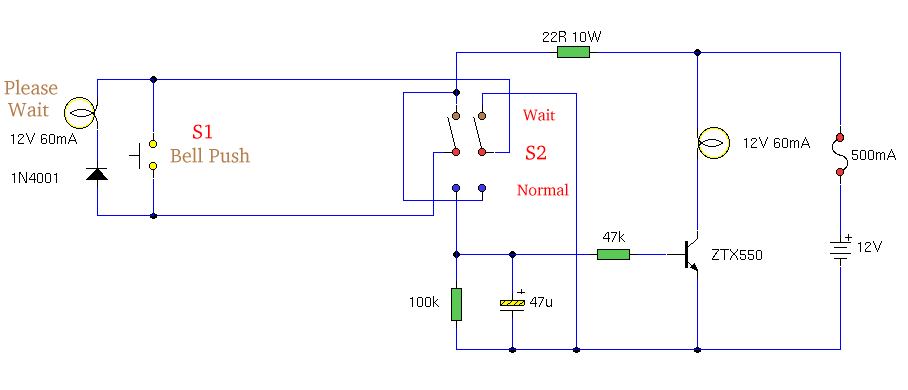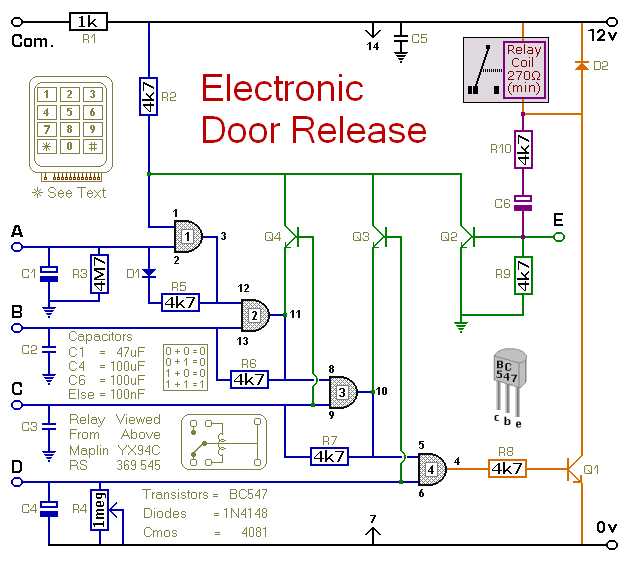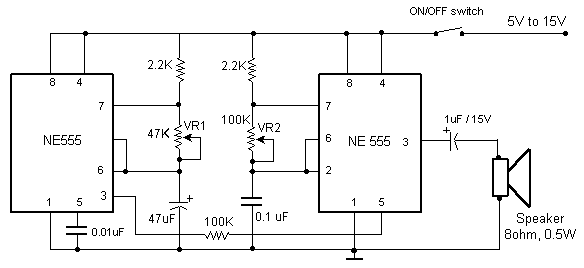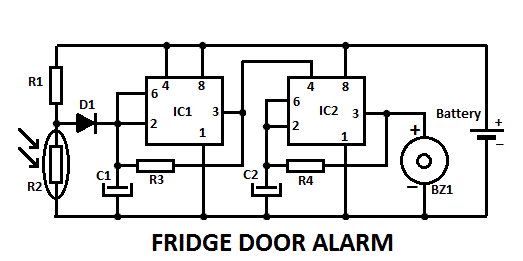
Door Chime with ATtiny12
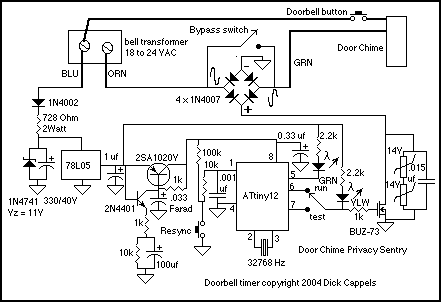
The device described here does just that. The circuit connects to the doorbell circuit, taking power from the 18 VAC from the doorbell transformer and switching power to the doorbell circuit most of the day. The user interface is a pushbutton, a toggle switch, and two LEDs. One LED, the green one, blinks at 1 Hz, just to give some comfort that the circuit is working. The amber LED glows whenever the doorbell is disabled. To set the timer, the user pushes the button momentarily, and when it is released, the amber LED will come on and the doorbell circuit is disabled (the doorbell button doesn't work) for a 10-hour period. At the end of the 10-hour period, the amber LED goes off and the doorbell is enabled. More: 24 hours after the button was last pushed, the amber LED comes back on and the door chime circuit is disabled again. This cycle repeats every 24 hours, and because its timing is set by a crystal oscillator, it should be able to go for months or years without needing to be reset. The circuit consists of a power supply, a capacitor backup circuit, an Atmel ATtiny12 microcontroller as a timer, and a solid-state relay circuit to switch the AC voltage in the doorbell circuit. The simple user interface is comprised of a resync button to synchronize the timer, a bypass switch to bypass the timer if desired, and two status indicator LEDs. It is designed to be used by people who are not technically inclined. The bell transformer, the doorbell button, and the doorbell are not in the enclosure; they are built into the house. The bypass switch and resync (or reset) button are mounted on the enclosure. Power for the circuit is derived from a half-wave rectifier. One end of the bell transformer (the one with the orange wire, marked "ORN" connected to it) connects to circuit common each half cycle through one of the diodes in the diode bridge. During the same half cycle, the 1N4002 conducts, charging the 330 µF capacitor up to a maximum of 11 volts. The filtered voltage powers the 78L05 5-volt regulator. The current is limited with the 728 Ohm dropping resistor to a maximum of 30 milliamps in order to minimize the maximum load on the bell transformer and to limit the amount of power that could be dissipated by any component on the board in the event of a component failure. The use of eight 1/4 watt resistors connected in series provides additional safety compared to using a single 750 Ohm 2 Watt resistor, as the power dissipated will be spread over a larger area of the phenolic circuit board. As a rule, resistors are not used beyond 50% of their rated power; in this case, the resistor string operates at 35% of rated power. A 0.033 farad capacitor is connected to the 2SA1020Y and the 2N4401 to provide backup power to keep the timer running in the event of a power failure. The 2N4401 connects the output of the 5-volt regulator to the ATtiny12 microcontroller when AC voltage is present and disconnects the controller's power supply from the LEDs when AC voltage is not present. This disconnection prevents the LEDs from discharging the 0.033 farad capacitor. The 2N4401 turns on the 2SA1020Y when power is first applied to the circuit, then quickly disconnects itself when the +5 volts starts to dip. The 0.033 farad capacitor supplies voltage to the ATtiny12 through a 1k resistor. An alternative, the 2N2907, can be used in place of the 2SA1020Y.The device described here does just that. The circuit connects to the doorbell circuit - taking power from the 18 VAC from the doorbell transformer and switching power to the doorbell circuit most of the day. The user interface is a pushbutton, a toggle switch, and two LEDs. One LED - the green one -blinks at 1 Hz, just to give me some comfort that the circuit is working. The amber LED glows whenever the doorbell is disabled. To set the timer, you just push the button momentarily, and when its released, the amber LED will come on and the doorbell circuit is disabled (the door bell button doesn't work) for a 10 hour period.
At the end of the 10 hour period, the amber LED goes off and the doorbell is enabled. 24 Hours after the button was last pushed, the amber LED comes back on and the door chime circuit is disabled again. this cycle repeats every 24 hours, and because its timing is set by a crystal oscillator, it should be able to go for months or years without needing to be reset.
The circuit consists of a power supply, a capacitor back-up circuit, a Atmel ATtiny12 microcontroller as a timer, and solid state realy circuit to switch the AC voltage in the doorbell circuit. The simple user interface is comprised of a resync button to synchronize the timer, a bypass switch to bypass the timer if desired, and two status indicator LEDs.
It is designed to be used by people who are not technically inclined. The bell transformer, the doorbell button, and the doorbell are not in the enclosure - they are built into the house. The bypass switch and resync (or reset) button are mounted on the enclosure. Power for the circuit is derived from a half wave rectifier. One end of the bell transformer (the one with the orange wire, marked "ORN" connected to it) connects to circuit common each half cycle through one of the diodes in the diode bridge.
During the same half cycle, the 1N4002 conducts, charging the 330 uf capacitor up to a maximum of 11 volts. The filtered voltage powers the 78L05 5 volt regulator. The current is limited with the 728 Ohm dropping resistor to a maximum of 30 milliamps in order to minimize the maximum load on the bell transformer, and to limit the amount of power that could be dissipated by any component on the board in the event of a component failure.
The use of eight 1/4 watt resistors connected in series makes me feel a little more comfortable than using a single 750 Ohm 2 Watt resistor since the power dissipated will be spread over a large area of the phenolic circuit -pheonlic tends to discolor from heat more easily than fiberglass board, and even if a few of the resistors shorted, the others would be able to handle the increased dissipation -giving a little extra safety. As a rule, I don't use resistors beyond 50% of their rated power. In this case, the resistor string runs at 35% of rated power. A .033 farad (not microfarad) capacitor is connected to the 2SA1020Y and the 2N4401 to provide backup power to keep the timer running in the event of a power failure.
The 2N4401 is there to connect the output of the 5 volt regulator to the ATtiny12 microcontroller when AC voltage is present, and more importantly, to disconnect the controller's power supply from the LEDs when AC voltage is not present. Disconnecting the ATtiny12 from the LEDs keeps the LEDs from discharging the .033 farad capacitor. The 2N4401 is there to turn on the 2SA1020Y when power is first applied to the circuit, then to quickly disconnect itself from the circuit when the +5 volts starts to dip.
The .033 farad capacitor supplies voltage to the ATtiny12 through the 1k resistor. By the way, you can use an 2N2907 in place of the 2SA1020Y. 🔗 External reference
At the end of the 10 hour period, the amber LED goes off and the doorbell is enabled. 24 Hours after the button was last pushed, the amber LED comes back on and the door chime circuit is disabled again. this cycle repeats every 24 hours, and because its timing is set by a crystal oscillator, it should be able to go for months or years without needing to be reset.
The circuit consists of a power supply, a capacitor back-up circuit, a Atmel ATtiny12 microcontroller as a timer, and solid state realy circuit to switch the AC voltage in the doorbell circuit. The simple user interface is comprised of a resync button to synchronize the timer, a bypass switch to bypass the timer if desired, and two status indicator LEDs.
It is designed to be used by people who are not technically inclined. The bell transformer, the doorbell button, and the doorbell are not in the enclosure - they are built into the house. The bypass switch and resync (or reset) button are mounted on the enclosure. Power for the circuit is derived from a half wave rectifier. One end of the bell transformer (the one with the orange wire, marked "ORN" connected to it) connects to circuit common each half cycle through one of the diodes in the diode bridge.
During the same half cycle, the 1N4002 conducts, charging the 330 uf capacitor up to a maximum of 11 volts. The filtered voltage powers the 78L05 5 volt regulator. The current is limited with the 728 Ohm dropping resistor to a maximum of 30 milliamps in order to minimize the maximum load on the bell transformer, and to limit the amount of power that could be dissipated by any component on the board in the event of a component failure.
The use of eight 1/4 watt resistors connected in series makes me feel a little more comfortable than using a single 750 Ohm 2 Watt resistor since the power dissipated will be spread over a large area of the phenolic circuit -pheonlic tends to discolor from heat more easily than fiberglass board, and even if a few of the resistors shorted, the others would be able to handle the increased dissipation -giving a little extra safety. As a rule, I don't use resistors beyond 50% of their rated power. In this case, the resistor string runs at 35% of rated power. A .033 farad (not microfarad) capacitor is connected to the 2SA1020Y and the 2N4401 to provide backup power to keep the timer running in the event of a power failure.
The 2N4401 is there to connect the output of the 5 volt regulator to the ATtiny12 microcontroller when AC voltage is present, and more importantly, to disconnect the controller's power supply from the LEDs when AC voltage is not present. Disconnecting the ATtiny12 from the LEDs keeps the LEDs from discharging the .033 farad capacitor. The 2N4401 is there to turn on the 2SA1020Y when power is first applied to the circuit, then to quickly disconnect itself from the circuit when the +5 volts starts to dip.
The .033 farad capacitor supplies voltage to the ATtiny12 through the 1k resistor. By the way, you can use an 2N2907 in place of the 2SA1020Y. 🔗 External reference

